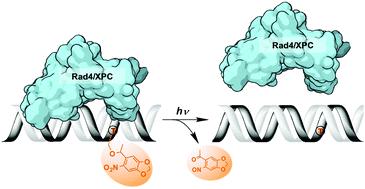当前位置:
X-MOL 学术
›
RSC Chem. Biol.
›
论文详情
Our official English website, www.x-mol.net, welcomes your
feedback! (Note: you will need to create a separate account there.)
Light-induced modulation of DNA recognition by the Rad4/XPC damage sensor protein
RSC Chemical Biology ( IF 4.2 ) Pub Date : 2021-1-6 , DOI: 10.1039/d0cb00192a Amirrasoul Tavakoli 1 , Debamita Paul 1 , Hong Mu 2 , Jagannath Kuchlyan 1 , Saroj Baral 3 , Anjum Ansari 3 , Suse Broyde 2 , Jung-Hyun Min 1
RSC Chemical Biology ( IF 4.2 ) Pub Date : 2021-1-6 , DOI: 10.1039/d0cb00192a Amirrasoul Tavakoli 1 , Debamita Paul 1 , Hong Mu 2 , Jagannath Kuchlyan 1 , Saroj Baral 3 , Anjum Ansari 3 , Suse Broyde 2 , Jung-Hyun Min 1
Affiliation

|
Biomolecular structural changes upon binding/unbinding are key to their functions. However, characterization of such dynamical processes is difficult as it requires ways to rapidly and specifically trigger the assembly/disassembly as well as ways to monitor the resulting changes over time. Recently, various chemical strategies have been developed to use light to trigger changes in oligonucleotide structures, and thereby their activities. Here we report that photocleavable DNA can be used to modulate the DNA binding of the Rad4/XPC DNA repair complex using light. Rad4/XPC specifically recognizes diverse helix-destabilizing/distorting lesions including bulky organic adduct lesions and functions as a key initiator for the eukaryotic nucleotide excision repair (NER) pathway. We show that the 6-nitropiperonyloxymethyl (NPOM)-modified DNA is recognized by the Rad4 protein as a specific substrate and that the specific binding can be abolished by light-induced cleavage of the NPOM group from DNA in a dose-dependent manner. Fluorescence lifetime-based analyses of the DNA conformations suggest that free NPOM-DNA retains B-DNA-like conformations despite its bulky NPOM adduct, but Rad4-binding causes it to be heterogeneously distorted. Subsequent extensive conformational searches and molecular dynamics simulations demonstrate that NPOM in DNA can be housed in the major groove of the DNA, with stacking interactions among the nucleotide pairs remaining largely unperturbed and thus retaining overall B-DNA conformation. Our work suggests that photoactivable DNA may be used as a DNA lesion surrogate to study DNA repair mechanisms such as nucleotide excision repair.
中文翻译:

Rad4/XPC 损伤传感器蛋白对 DNA 识别的光诱导调节
结合/解除结合时的生物分子结构变化是其功能的关键。然而,描述这种动态过程是很困难的,因为它需要快速、具体地触发组装/拆卸的方法,以及随着时间的推移监控所产生的变化的方法。最近,已经开发出各种化学策略来利用光来触发寡核苷酸结构的变化,从而引发它们的活性。在此,我们报道可光裂解 DNA 可用于利用光调节 Rad4/XPC DNA 修复复合物的 DNA 结合。 Rad4/XPC 特异性识别多种螺旋不稳定/扭曲病变,包括大块有机加合物病变,并作为真核核苷酸切除修复 (NER) 途径的关键启动子发挥作用。我们表明,Rad4 蛋白将 6-硝基胡椒氧基甲基 (NPOM) 修饰的 DNA 识别为特异性底物,并且可以通过光诱导 NPOM 基团以剂量依赖性方式从 DNA 上裂解来消除特异性结合。基于荧光寿命的 DNA 构象分析表明,尽管游离 NPOM-DNA 具有庞大的 NPOM 加合物,但仍保留 B-DNA 样构象,但 Rad4 结合导致其异质扭曲。随后广泛的构象搜索和分子动力学模拟表明,DNA 中的 NPOM 可以容纳在 DNA 的主沟中,核苷酸对之间的堆积相互作用基本上不受干扰,从而保留整体 B-DNA 构象。我们的工作表明,光敏 DNA 可以用作 DNA 损伤替代物来研究 DNA 修复机制,例如核苷酸切除修复。
更新日期:2021-01-06
中文翻译:

Rad4/XPC 损伤传感器蛋白对 DNA 识别的光诱导调节
结合/解除结合时的生物分子结构变化是其功能的关键。然而,描述这种动态过程是很困难的,因为它需要快速、具体地触发组装/拆卸的方法,以及随着时间的推移监控所产生的变化的方法。最近,已经开发出各种化学策略来利用光来触发寡核苷酸结构的变化,从而引发它们的活性。在此,我们报道可光裂解 DNA 可用于利用光调节 Rad4/XPC DNA 修复复合物的 DNA 结合。 Rad4/XPC 特异性识别多种螺旋不稳定/扭曲病变,包括大块有机加合物病变,并作为真核核苷酸切除修复 (NER) 途径的关键启动子发挥作用。我们表明,Rad4 蛋白将 6-硝基胡椒氧基甲基 (NPOM) 修饰的 DNA 识别为特异性底物,并且可以通过光诱导 NPOM 基团以剂量依赖性方式从 DNA 上裂解来消除特异性结合。基于荧光寿命的 DNA 构象分析表明,尽管游离 NPOM-DNA 具有庞大的 NPOM 加合物,但仍保留 B-DNA 样构象,但 Rad4 结合导致其异质扭曲。随后广泛的构象搜索和分子动力学模拟表明,DNA 中的 NPOM 可以容纳在 DNA 的主沟中,核苷酸对之间的堆积相互作用基本上不受干扰,从而保留整体 B-DNA 构象。我们的工作表明,光敏 DNA 可以用作 DNA 损伤替代物来研究 DNA 修复机制,例如核苷酸切除修复。











































 京公网安备 11010802027423号
京公网安备 11010802027423号